Consumers Want to Travel Sustainably, Are They Acting on It?


(Image: CHUTTERSNAP/Unsplash)
Seventy-five percent of Americans intend to include sustainability among their priorities when traveling, according to a new report from Washington State University (WSU). But not everyone follows through. Understanding why could help sustainable hospitality businesses increase their share of bookings and encourage a greater portion of the industry to follow suit. This would likely lead to a reduction in the travel industry’s share of emissions, which were estimated to make up 8 percent of the world’s emissions in 2023 and are expected to increase exponentially by 2050 if the right steps aren’t taken.
Travelers need more information to make sustainable choices
“There is almost always a gap between what consumers say and do, especially when it's about green consumption,” Christina Chi, a professor at WSU’s School of Hospitality Business Management, told TriplePundit. This can happen for several different reasons, including the tendency for survey respondents to choose the option seen as socially desirable.
“Customers have different experiences and perceptions with green products and services, which can affect their green actions,” Chi said. Those perceptions influence what consumers consider sustainable, and could explain why the choices they intend to make don’t necessarily line up with the greatest emissions reductions. For example, instead of choosing low-emission flights, green-certified accommodations, or using public transportation systems as actions they were likely to take when traveling, survey respondents prioritized activities with less potential to affect their carbon footprint.
“The top four answers there [were] purchase goods from local businesses and sellers, avoiding tourism activities or behaviors that would harm wildlife or the environment, dining at establishments that get ingredients from regional farmers and producers, and doing what you can to avoid contributing to over-tourism of popular areas,” Debbie Compeau, the interim dean of WSU’s Carson College of Business and Research, told 3p. “What that says to me is, behaviorally, the way they are defining sustainability is around supporting the economy of different places and avoiding harm.”
While these steps are all integral to responsible travel, incentivizing and educating consumers on the importance of lower-carbon transportation and accommodations is imperative to making the industry more sustainable. But that’s not happening. Having a green certification doesn’t lead to more bookings or higher revenue for hotels, according to another study led by Chi. She noted that hotels have largely removed certifications from their websites and many no longer advertise their efforts.
“Hotel greenwashing has eroded customers' trust of hotels' green claims and caused them [to be] less willing to participate in hotels' sustainability practices,” Chi said. Likewise, airlines often fail to disclose emissions details, which would allow passengers to choose flights with the lowest carbon footprint. “Tourism and hospitality businesses that are environmentally friendly often fail to provide essential information,” she added.
A priority, but not a top priority
While 75 percent of survey respondents cited sustainability as a travel priority, not everyone said it was a top priority. Only 13 percent listed it as such. Meanwhile, 33 percent categorized sustainability as an important travel priority and 29 percent said it was a secondary priority, which is considered a minor influence, Compeau said.
Although three out of four people may consider sustainability in their travel plans, it’s likely that only a small percentage are putting it into action. Compeau said she assumes there is less of a gap between what people say and what they do in the 13 percent who categorize it as a top priority.
Priorities vary by generation
“We revealed numerous generational differences regarding sustainability in this survey,” Chi said. “For example, Gen Z and millennials are significantly more likely than older generations to say sustainability is a ‘top priority’ when traveling — 20 percent and 18 percent, respectively.”
Their choices of travel practices reflected that prioritization, with almost a quarter of Gen Z and millennials listing “flying with airlines that are committed to greener operations” as important. That’s compared to just 9 percent of Gen X and 7 percent of baby boomers who said the same.
That dichotomy held for low-carbon local transportation, as well. And while a mere 5 percent of Gen X and 4 percent of baby boomers thought it was important to stay in green-certified accommodations, 13 percent of those in the younger generations considered it a priority.
Parents of young children also reported a greater affinity for sustainable travel than parents of adults or people without kids. Thirty-four percent of parents agreed with the statement “I feel a responsibility to plan and act sustainably when I travel.”
“Honestly, age may be an important variable here, at least to some degree,” Chi said. “The parents in the survey … are generally younger, making them millennials themselves … Perhaps they have their children, and their children’s future world, on their minds.”
The future of travel depends on acting on sustainable travel intentions
Everyone can take steps to travel more sustainably. From booking lower-emissions flights and accommodations with lower carbon footprints to choosing public transportation at destinations, there are plenty of ways to do so. That might mean doing more research during the planning phase of a trip, such as searching for LEED-certified lodging, checking carbon emissions on Google Flights, and learning about the local public transportation system before arrival. It can also mean choosing hostels and guesthouses — which have smaller footprints due to their smaller size and maximized communal spaces — and focusing on direct flights whenever possible.
Sustainable travel options should increase as more consumers prioritize them, with venues and airlines more likely to advertise their certifications and emissions savings as they see a financial benefit. Moreover, the climate crisis threatens tourism around the planet. Islands and beaches are at risk of rising seas, extreme heat and weather pattern changes can destroy the viability of destinations, and so on. It is imperative that both travelers and the travel industry take the right steps to drastically reduce emissions and embrace sustainability.
Seeing is Believing: What Project 2025 Means for Business
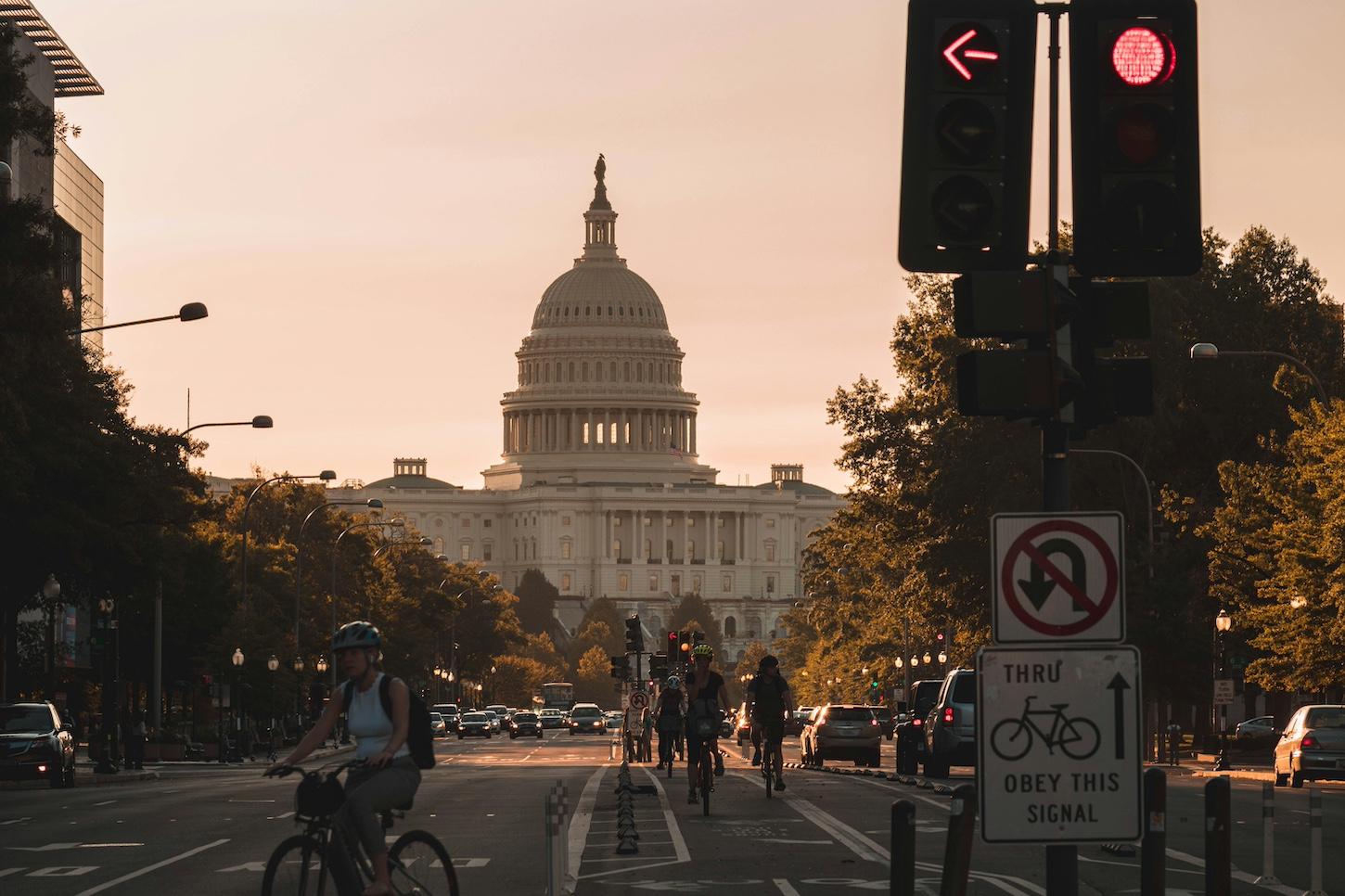
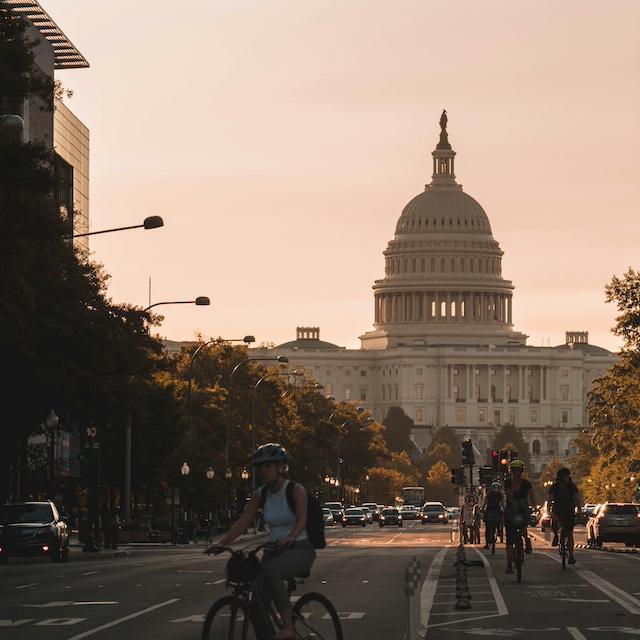
(Image: Andy Feliciotti/Unsplash)
A detailed plan for upending the federal government is easily available for public view on the Heritage Foundation’s website. Known as Project 2025, the document has sat there for months, flying largely under the media radar. Actress Taraji P. Henson finally called attention to the draconian plan in a fiery speech while hosting the annual BET Awards show, and now everyone is talking about it.
Why is everyone suddenly talking about Project 2025?
Project 2025 previously received some attention from the Union of Concerned Scientists and other climate experts. However, in terms of raising widespread public awareness about it, Henson provided a compelling, effective spark that broke through the media clutter, and BET Networks later posted a clip of her speech to YouTube.
“Pay attention,” Henson urged, looking straight into the camera. “It’s not a secret. Look it up … The Project 2025 plan is not a game. Look it up!”
CNN, Forbes, the Associated Press and the BBC are among the many media organizations to report on Project 2025 following the BET Awards, along with a wave of conversation across social media. Despite the sudden spotlight, the Project 2025 agenda is still available online from the Heritage Foundation in a free PDF format as part of the organization’s Mandate for Leadership series. It is also for sale in book form.
“The Heritage Foundation is once again facilitating this work, but as our dozens of partners and hundreds of authors will attest, this book is the work of the entire conservative movement,” the organization’s website reads. “It is not enough for conservatives to win elections … we need both a governing agenda and the right people in place, ready to carry this agenda out on day one of the next conservative administration.”
What Project 2025 means for business
The Project 2025 agenda spans 922 pages, much of it spelling out steps to mandate government-enforced social control at a granular level, with a knock-on impact that could undermine corporate diversity, equity and inclusion (DEI) initiatives.
“The next conservative president must get to work pursuing the true priority of politics — the well-being of the American family,” the PDF version reads. “The Dobbs decision is just the beginning,” it continues, referring to the U.S. Supreme Court’s decision in Dobbs v. Jackson Women's Health Organization that effectively overturned federal protections for abortion.
That’s just the first of four topic areas described in Project 2025. The others deal more directly with policies impacting economic activity.
For example, an op-ed authored by former Microsoft executive Jeff Raikes and published by Forbes sums up the entire document as a policy agenda that will “likely plunge the American economy into a death spiral.” In an echo of Henson’s warning, Raikes advises taking Republican presidential candidate Donald Trump’s extremist statements on the campaign trail literally.
“It'd be natural to think that Trump is just mouthing off again, except, this time, he has a playbook in hand to accomplish his goals as soon as he gets into office,” Raikes wrote.
He also drew out the connection between a healthy economy and a functioning democracy, adding to a growing body of commentary on the business case for democratic representation.
“Unfortunately, this Project 2025 agenda is brimming with extremely outside-the-mainstream ideas that threaten to roll back many Americans' fundamental rights and cause grave and perhaps permanent damage to our democratic system of government,” he wrote.
The 800-pound climate change gorilla in the Project 2025 room
Early signs of Raikes' “death spiral” warning have already emerged as the U.S. insurance industry grapples with the impacts of climate change. Raikes notes that Project 2025 refers dismissively to the “climate change alarm industry," but the economic impacts are all too real.
“Climate change is already costing the U.S. $150 billion a year, and those costs are expected to grow substantially in the years to come if left unchecked — which is what this report argues for,” Raikes wrote, referring to a 2023 report from the U.S. National Oceanic and Atmospheric Administration (NOAA).
Indeed, insurers are already pulling out of Florida and other markets on the front lines of climate change-related impacts.
“Industry leaders note that insurance companies have been hammered by heavy payouts … and say they simply can’t afford to provide coverage in the areas that face the highest risk,” Alex Brown reported for the nonprofit news organization Stateline last month.
Despite the looming threat of a full-blown climate crisis, rapid decarbonization and adaptation will reduce risks and limit the damage, according to the NOAA report. With that, the choice on Election Day this year is clear and binary: Support the climate policies of the Joe Biden administration, or go down with the Project 2025 ship.
HBCUs are Leading the Fight for Environmental Justice
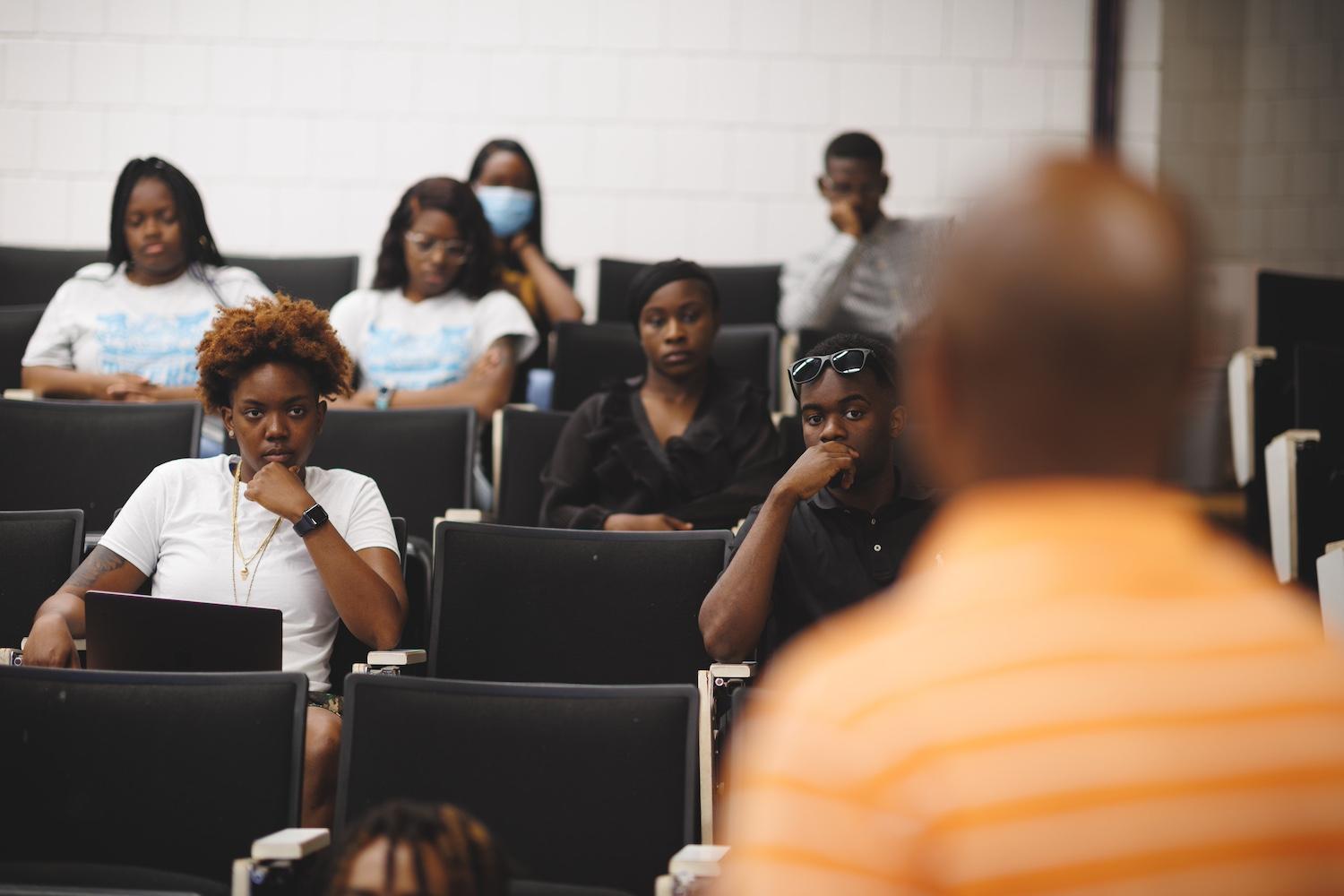
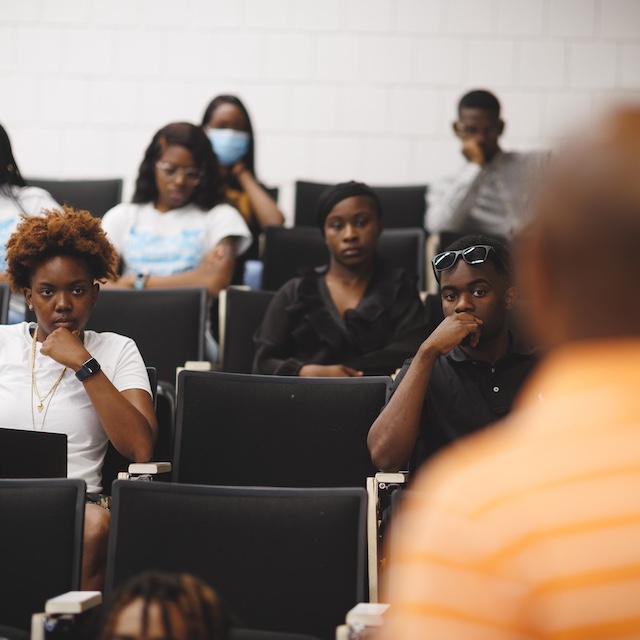
(Image: Andrew Huth)
The impact of climate change falls most heavily on disadvantaged communities, including many Black communities in the southern United States. Historically Black colleges and universities (HBCUs) are “uniquely positioned to lead” in the struggle for climate justice and environmental resilience, according to a report from the United Negro College Fund.
“HBCUs are particularly well suited to lead efforts in climate justice due to their deep-rooted connections to communities that they already have,” Kendra Sharp, a strategist for the fund’s Institute for Capacity Building, told TriplePundit. “They have been disproportionately affected by environmental injustices for so long that they now can use that setback as a strength to help influence the conversation.”
The report analyzes existing climate and sustainability practices at HBCUs and, with support from the climate-solutions-focused Waverley Street Foundation, charts a course for launching a network of HBCU Climate Action Hubs.
The long histories of HBCUs advocating for social justice and equality means they are “natural leaders” in addressing the “compounded issues of environmental and racial injustices as it relates to climate and sustainability overall,” Sharp said. “HBCUs are uniquely positioned to take their mission, which is obviously to serve under-resourced students and communities, and pair that up with this urgent need for climate action as it relates to our communities … Leveraging this expertise can definitely drive meaningful change.”
Black communities are heavily concentrated in regions that overlap with severe climate risks, primarily in southern states, according to a November 2023 report by the McKinsey Institute for Black Economic Mobility. Roughly half of Black Americans live in the Southeast where exposure to heat, hurricanes and flooding is high. Consequently, Black populations are more likely to be exposed to these dangers.
The United Negro College Fund’s report surveyed 20 HBCUs representing a mix of public and private schools located in urban, suburban and rural settings. The findings revealed that HBCUs have already had a strong commitment to climate, climate justice and sustainability for quite some time, Sharp told 3p.
Eighty-five percent of HBCUs already run green programs, highlighting their commitment to sustainability. These initiatives include curriculum enhancements, incorporating solar panels, forming student-led environmental groups, establishing community gardens, and promoting biking and walking trails. And 44 percent of the schools rated climate and sustainability initiatives “extremely or very important” compared to other priorities, indicating a strong commitment to addressing these issues.
As a result, HBCUs are molding a new generation of environmental leaders through innovative sustainability education. Half of the surveyed schools offer degree programs or certifications in fields critical to sustainability.
“Another thing that the survey revealed was the particular, special space for HBCU presidents and how they are viewed at such a high stature in the black community,” Sharp said. “HBCU presidents are well suited to use this influence to enhance climate and sustainability agendas at their institutions and in the communities where these institutions sit.”
And they’re prepared to drive transformative environmental justice and climate action for their communities. Eighty percent of the institutions surveyed participate in continuing education on climate and sustainability, including student-led projects, festivals, conferences, and engagement campaigns that are open to the public.
Despite these positive factors, just 15 percent of HBCUs have a specific budget allocated for climate and sustainability projects, highlighting the scarcity of financial resources available in these critical areas.
“Persistent underfunding significantly hampers the ability for HBCUs to be innovative and to advance their sustainability efforts,” Sharp said. “It creates a space where they have limited access to state-of-the-art technology and to research opportunities, although there is research happening. Another big piece that may not be as highlighted is having skilled personnel and experts in this space.”
HBCUs that want to lead on addressing climate justice know the importance of forging strategic relationships with governmental agencies, nonprofits, and the private sectors that focus on climate and sustainability work, Sharp said. Some HBCUs are engaging in fundraising campaigns specifically targeted at supporting climate and sustainability initiatives and working with alumni who are passionate about these issues to push those agendas forward.
Ceres' New Guidance Shows Leaders How to Build a Climate Plan Step-By-Step


(Image: Vidar Nordli-Mathisen/Unsplash)
Ceres, the nonprofit sustainability organization, recently released guidance to help companies take the next step in their climate strategies. Released in June, it’s aimed at corporations developing and evaluating a climate transition plan. The document provides a step-by-step path for corporate decarbonization strategies and aligns with the International Sustainability Standards Board reporting requirements.
“That was the impetus for this report,” said Laura Draucker, senior director of corporate climate action at Ceres and lead author of the report. “How do you understand what you're currently doing as a company, and move it towards what we call a ‘leading transition plan’ where it's fully integrated into a company's strategic plan?”
Climate plans differ from climate disclosures. Climate disclosures are snapshots in time or backward-looking statements. They identify risks and opportunities in the current moment, as well as the environmental impacts of a company’s activities.
Climate transition action plans are forward-looking statements that lay out goals and targets for decarbonizing a company’s value chain and its plans for managing the risks and opportunities that climate change presents.
Investors want to see corporate climate plans
In the face of climate change, businesses are exposed to physical and transition climate risks. How storms or weather patterns affect capital assets and production are categorized as physical climate risks, while transition climate risks cover how companies have to comply with the evolving regulatory landscape.
Climate risks affect financial performance, and investors want assurance that companies are prepared for and managing these risks appropriately.
“Investors want evidence of implementation,” Draucker said. “They want to feel confident that their climate targets cover the company’s full emissions and that the actions they're taking, or planning to take, are going to move them towards meeting that goal.”
Over 600 investors managing $42 trillion in assets called for public disclosure of independently verified corporate climate plans in 2022.
What if you don’t have a perfect climate transition plan?
When it comes to building a climate transition plan, a lot of companies don’t know where to start, are overwhelmed by the size of the task, or fear they are going to do it wrong — all of which can lead to hesitation or inaction. Fear of failure was brought up during a workshop led by Ceres at the recent GreenFin 2024 sustainability finance conference in New York.
A representative from General Mills spoke about this fear, and how the company was unsure whether to publicly share that they have a large gap in their emissions and don’t know exactly what to do with it, Draucker said.
“They went through a stakeholder process with Ceres,” Draucker said. “All of their peers, investors, and other stakeholders said, ‘please report that information because none of us know exactly how we’re going to do everything we need to do.’”
One of the important things for business leaders and sustainability professionals to keep in mind is that nobody, not even regulators, expects perfection when it comes to climate plans. What they expect is honesty, transparency, and a commitment to responsibly managing climate impacts and risks.
A climate plan evolves with time as new information and technology become available. Sustainability leaders don’t need to get everything right from the start.
“If in 2024 a company has to say, these are the things we can do now, and these are the areas of emissions that we don’t know how to address yet, that’s fine,” Draucker said. “When they update their plan in 2025, or 2026, or whenever they decide to do it, maybe then they have more information and can start to fill in those gaps.”
How to start a climate transition plan
The Ceres guidance document is a useful reference for companies that need to develop a transition plan and for companies that want to evaluate their existing plan.
The guidance walks through the different aspects of a climate transition plan by outlining how to set goals and targets, how to decarbonize, how to track and report progress, as well as how to ensure a just transition and advocate for public policy. When it comes to developing a forward-looking climate plan, it all starts with buy-in from executive leadership.
“Executive buy-in is critical,” Draucker said. “There’s a lot that sustainability teams can do in the absence of leadership, but it's going to be difficult if leadership is making decisions without considering the climate impacts.”
The path to decarbonization starts with determining the largest sources of emissions across a full value chain, according to Ceres. The company can then identify strategies to reduce those emissions, estimate the expected emission reductions, and select meaningful metrics to set goals and track progress.
While there will certainly be some bumps in the road, the sooner companies start developing their climate transition plans, the more prepared they will be for regulations that require climate plan disclosure, like the EU’s Corporate Sustainability Reporting Directive.
There are, however, real advantages to implementing a strong climate plan beyond regulatory compliance and environmental stewardship.
“Unilever and Mars, which are both leaders in this space, talk about the competitive advantage they see in having a transition plan and actually implementing it,” Draucker said. “Companies should use this guide to help them get that leadership buy-in and move from just having a climate disclosure to a leading transition plan.”
Hybrid Grapes Are Paving the Way for Sustainable Vineyards


(Image: David Köhler/Unsplash)
Stretching back to 6000 B.C., wine is one of our oldest alcoholic drinks. Steeped in tradition from location to religious rites, it doesn’t exactly inspire thoughts of innovation. Yet the wine industry is adapting.
As the impacts climate change reach across our planet, wineries are caught in the crosshairs. An astounding 70 percent of the world’s wine-producing regions may become unsuitable if global temperatures rise above 2 degrees Celsius over preindustrial levels, according to recent research.
To add insult to injury, increased disease is another potential impact of global warming. Unfortunately, vineyards are already plagued with expensive fungal diseases, costing at least $1.5 billion per year to replace dead vines globally.
Yet there’s an underdog in the wine world ripe for saving the day: hybrid grapes. Once passed over for more traditional wines like merlot or malbec, these grapes are coming into their own. Resistant to many diseases, could hybrids be the key to a more sustainable, wine-forward future?
Hybrid wine 101
Hybrid wines are a little different than their purebred counterparts. The familiar varieties of wine — like chardonnay, cabernet sauvignon and riesling — all come from the European grapevine Vitis vinifera.
Yes, that stunning array of wines in the supermarket aisle is just one species. Hybrids are a cross between two different species, usually the European Vitis vinifera with the North American species Vitis labrusca or Vitis riparia.
Hybrids have several advantages. Besides disease resistance, they flourish in colder climates. If you’ve gone wine-tasting in a region like New York or Michigan, you may have tried varieties like chambourcin, traminette or vidal blanc.
While hybrids are nothing new, they haven’t always been in favor. They were banned in certain European wine regions until 2021. Despite that, some areas have grown hybrid wines for centuries.
“In Germany, we've always had quite a long history with crossbreeding because we have a cool climate region here, which means that we have a lot of problems with fungi, a lot of pressure on the grapes with sickness,” said Florian Koch, head of education at the German Wine Institute. “You can look back even to the beginning of the 19th century, the first cross-breedings were introduced simply with the goal of increasing the resistance to fungi and different diseases.”
The rest of the world is wising up to hybrid wines’ appeal for a good reason: pesticide use.
Pesticides in your pinot
Your favorite cabernet might bring dark fruit and chocolate to mind, but unfortunately, pesticides are probably in there too. For instance, a recent study found 25 different pesticide residues in wine. Fungicides and insecticides were the most common.
That’s not surprising given French vineyards are sprayed 20 times per year with pesticides. This helps ward off diseases, insects, and weeds but also damages soil biodiversity, pollutes water, and harms wine growers, workers and neighbors. These chemicals can end up at the consumers’ door (or lips). Even organic wines use copper sulfate to combat diseases, which can harm the soil if used in excess.
Things aren’t looking rosier as climate change intensifies. Wine is particularly sensitive to climate change, with water scarcity and heat already threatening the industry. But that’s not all, diseases are looming on the horizon. While global predictions for major grapevine diseases — including downy mildew, powdery mildew and gray mold — are uncertain under climate change, some regions are bracing for an impact. For instance, New Zealand could lose up to $100 million per year from increasing fungal infections.
Hybrid grapes as a sustainable solution
Despite this bleak outlook, hybrid grapes, which are resistant to many fungal and bacterial diseases, are a promising solution. Switching to hybrid grapes from traditional ones can decrease pesticide use by up to an astounding 90 percent, Koch said. They also fit squarely into the new set of agricultural policy initiatives in the European Green Deal.
“In Europe, we have the Green Deal, which [includes] an agreement of the European states to reduce the use of [pesticide] sprayings by 50 percent overall,” Koch said. “So this is a big help for us if we've got grape varieties where we can drastically reduce the use of sprayings. Also, we've got a plan to go organic by 30 percent of our acreage.”
In addition, Koch explained that hybrids can have other advantages such as withstanding intense sunlight, being easier to harvest and having looser clusters — which further reduces susceptibility to fungus. Many hybrids can also withstand extreme weather and are ideal for producing dessert, ice wines.
Hindrances to hybrid adoption
In spite of their benefits, hybrid grapes are still novel. They’re planted in less than 5 percent of vineyards globally for a variety of reasons. For starters, marketing a new, unknown wine can be challenging since grape variety is critical in wine choice.
“The huge problem is that we do not have the profile of [hybrid grapes] as of now because the winemakers only knew about these varietals for 10 to 15 years,” Koch said. “When you're thinking of riesling, you think high acidity, very aromatic, lemon tones, green apple, honey. But when you're thinking of johanniter, you have no idea what it's going to be like.”
Then there’s the critical factor in wine taste: terroir, or the environmental factors of the region that influence production.
“Riesling or silvaner, for example, are heavily influenced by the terroir, by climate, by soil, by the rocks that you have, by yeast, by sunshine hours,” Koch said. “And we do not know yet how this will affect stuff like vidal blanc. We’ll have to wait and see. We've got 2000 years of experience with riesling but two years of experience with cabernet blanc.”
Koch pointed out that wine name also matters. For instance, the German name for hybrid grapes, pilzwiderstandsfähige reben, translates to “fungus-resistant grape varieties,” hardly the most appealing moniker. And laboratories have created other, difficult-to-pronounce names for hybrid wines.
Future of wine
Despite this fledging market, interest in sustainable wine is on the rise, particularly in the United States and United Kingdom. While the overall wine market in the U.S. is predicted to decline over the next few years, the organic, natural, sustainable and biodynamic segment is poised to grow. Nearly half of American drinkers consider sustainability in their purchasing decisions, while hybrids are among the fastest-growing wine varieties in Germany.
“Everyone is trying to do their best,” Koch said. “This is our version of it. We see the results and they're great, actually. I mean, reducing [pesticide] sprayings by up to 90 percent is immense — thousands of tons of sprayings in Germany alone. And it still produces amazing wines.”
Next time you’re in the wine aisle, try a bottle with a little hybrid vigor. After all, sustainability is always the perfect palate.
Aquacycl Makes Treating Industrial Wastewater Easier and More Effective
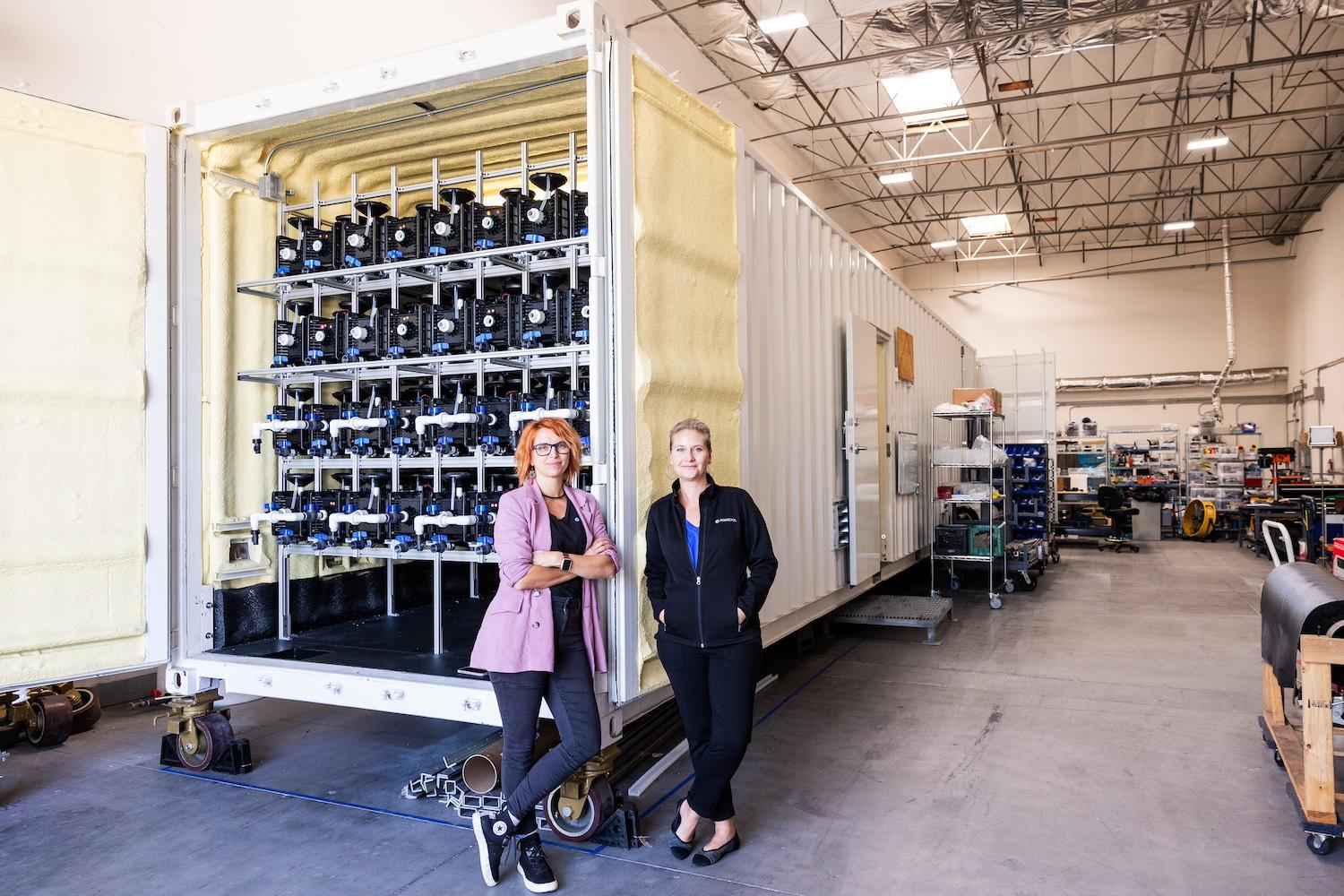
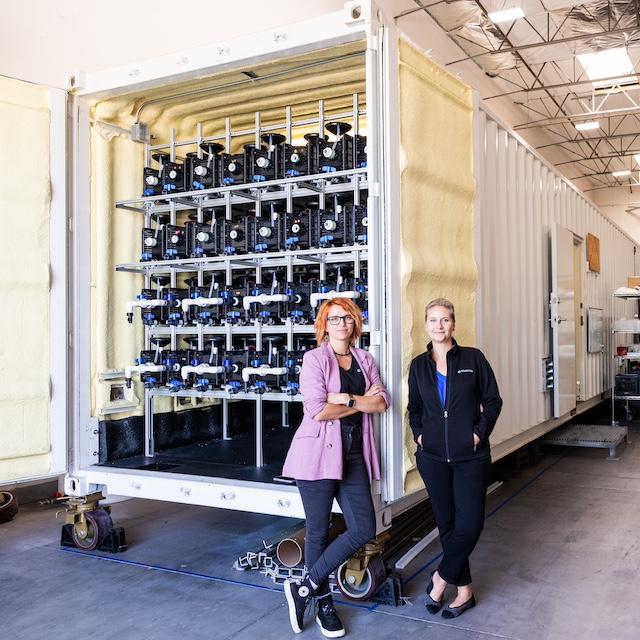
Orianna Bretschger (right), Aquacycl co-founder and CEO, and Sofia Babanova (left), co-founder and CTO, stand in front of the BioElectrochemical Treatment Technology wastewater treatment system stacked in a shipping container. (Image courtesy of Aquacycl.)
Despite improvements globally, 2 billion people in the world still lack access to drinking water services, and approximately 3.6 billion people — 46 percent of the world’s population — lack adequate sanitation, according to a United Nations World Water Development Report.
Orianna Bretschger can relate. Growing up with parents who moved around frequently, she lived in remote places like a ghost town outside of Fort Huachuca, Arizona, and off the grid at the base of the Cascade mountains in Oregon. Bretschger often lived without consistent access to running water or electricity, with gas lamps and fire for light and heat and an outhouse for sanitation.
From those experiences and a lot of science, she co-founded Aquacycl, a San Diego startup that provides sustainable and cost-effective industrial wastewater treatment services on-site using an innovative bacterial process. The process addresses industrial wastewater with a high biological oxygen demand (BOD). BOD is used as an index of the degree of organic pollution in water, according to the United States Geological Survey.
“The greater the BOD, the more rapidly oxygen is depleted in the stream [where the treated wastewater is ultimately discharged],” according to the U.S. Environmental Protection Agency. “This means less oxygen is available to higher forms of aquatic life.”
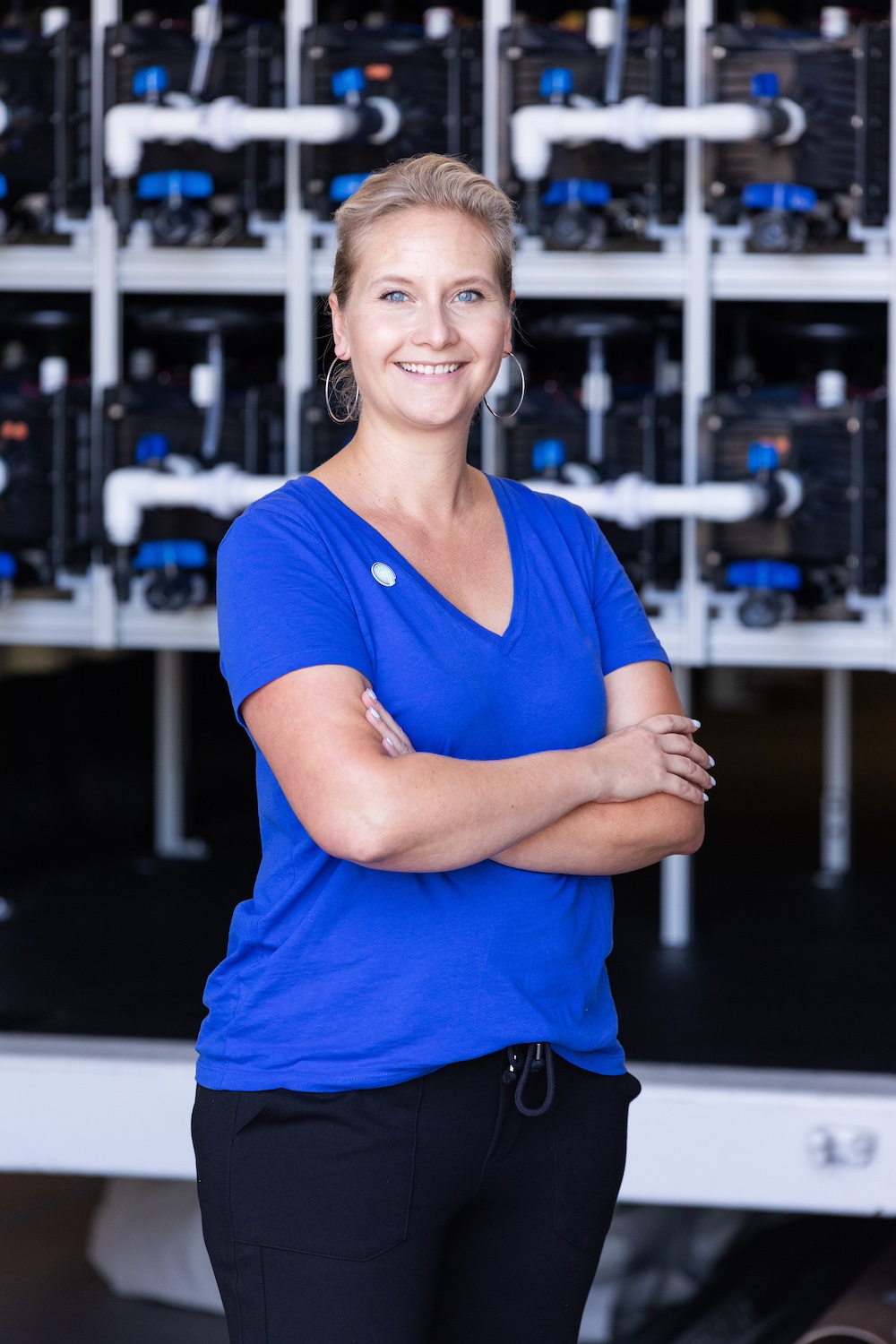
How the technology works
Aquacycl focuses on industrial discharge, which accounts for 30 percent of untreated global wastewater because it is the most challenging to treat. The firm addresses the wastewater problems of major brands operating large production facilities in smaller cities, where the municipalities’ existing facilities may find it difficult to deal with the discharge.
Aquacycl’s BioElectrochemical Treatment Technology relieves the local utility from processing industrial wastewater. This avoids the potential for discharge that has not been appropriately treated to end up in waterways where it could disrupt ecosystems. It also helps reduce infrastructure expenses and maintain fair pricing for all ratepayers in the municipality.
The system uses natural, locally-sourced bacteria to accelerate wastewater treatment rates, remove BOD, and eliminate and minimize sludge while simultaneously producing electricity.
The work starts in a little black box called a reactor. Each reactor is about the size of a standard car battery. Wastewater flows into the reactor, where the the locally-sourced microbes can consume the organics in the water. At the same time, the microbes are producing electrons as part of their natural metabolic and respiratory processes. Those electrons are captured by the reactor to generate power. The faster the electrons are removed, the faster the microbes eat.
The reactors are stacked together like building blocks inside a 40-foot shipping container. As the wastewater flows through each reactor, the microbes remove more organic carbon. Each shipping container can remove up to 3,000 pounds of BOD per day, according to Aquacycl.
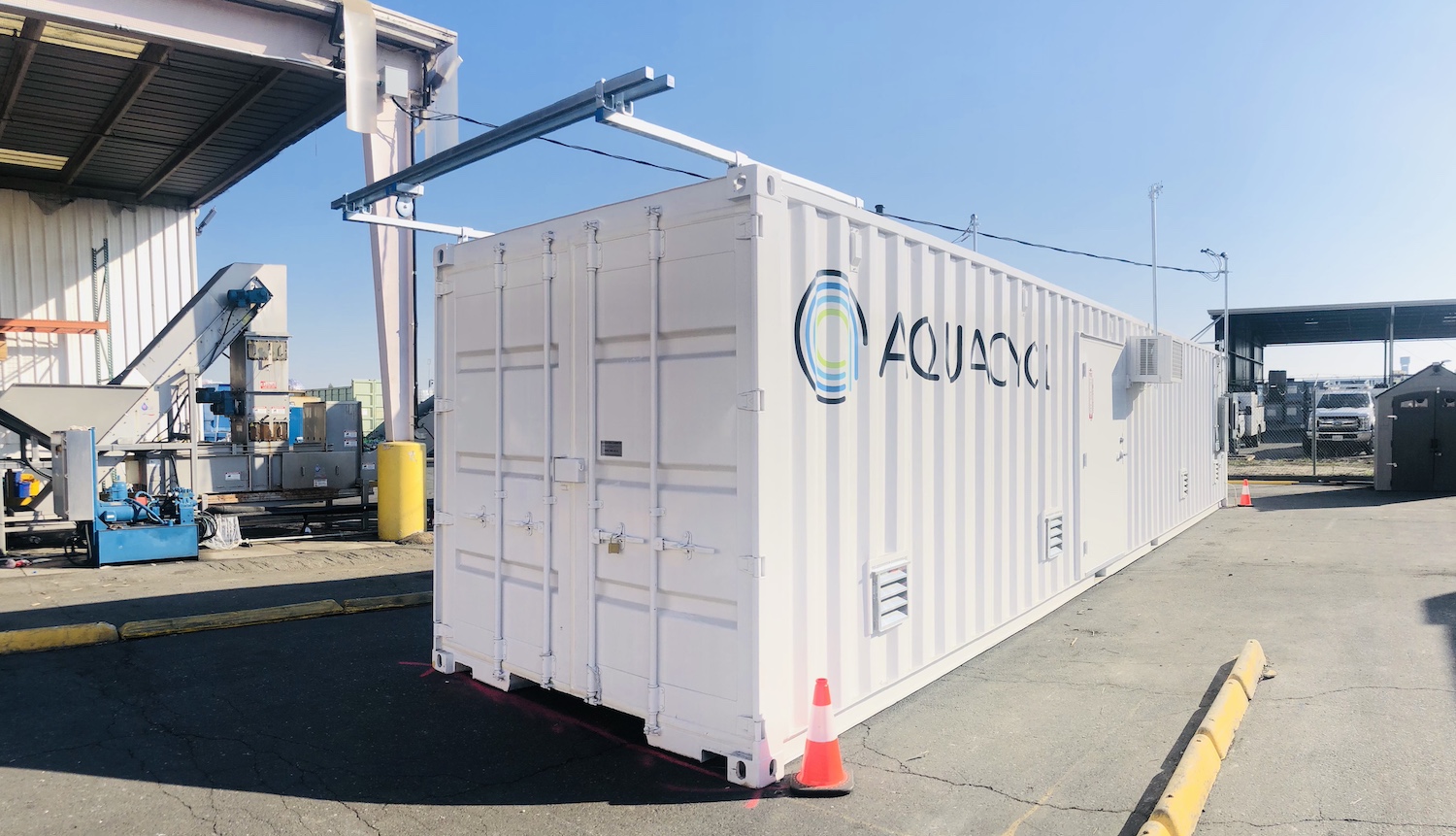
The electrical current produced by the bacteria can power the treatment equipment. Each reactor, and all of the integrated sensors, are monitored and controlled remotely from Aquacycl’s headquarters. The process saves municipalities energy and produces 90 percent less greenhouse gas emissions than traditional treatment systems.
At a PepsiCo installation in Fresno, California, Aquacycl’s installation exceeded the required standards for BOD removal and for total suspended solids, which can reduce the efficiency of wastewater treatment plants, according to the the Environmental Protection Agency. Ben Duncan, PepsiCo’s Fresno manufacturing leader, told the Fresno Business Journal that the technology will be a game changer for companies in the future, and Aquacycl is at the forefront of the clean wastewater initiative.
Other client successes include removing hydrocarbons from tank terminal wastewater, treating discarded beverages for a major food and beverage company, and treating sugar-laden wastewater from a confectionery plant.
Where it all began
Aquacycl’s award-winning technology had its beginnings at the University of Southern California, where Bretschger was first introduced to the concept that bacteria can generate electricity and clean water at the same time.
That work took her to the J. Craig Venter Institute, a research organization focused on advancing the science of genomics, where she expanded her understanding of how communities of organisms communicate electronically. There, she and her team explored how to build a practical technology for wastewater treatment. With a $5 million grant from the Roddenberry Foundation, Bretschger and her team brought the technology to field trials to learn if it could scale.
The first pilot treated manure on a pig farm at a high school in Escondido, California, and is still working today. The second was in Tijuana, Mexico, at a demonstration site called EcoParque, treating residential wastewater to irrigate hillside landscapes and vegetation.
The Escondido and the Tijuana pilots validated the water quality outputs and the overall scalability of the concept. As a result, Bretschger co-founded Aquacycl with Sofia Babanova, the company's chief technology officer, in November 2016 and the company has grown to employ over 20 people with over $20 million in investment.
What's next for Aquacycl
The firm now operates systems for clients in California, Nevada, Colorado and Texas, and tested pilot systems in Tennessee, Hawaii and Oregon. It will soon serve a tequila distillery outside Guadalajara, Mexico. Europe is an important potential growth area, and Aquacycl opened its first international office in Leeuwarden, the Netherlands, last year.
“As regulations in Europe and around the world continue to get stricter, and companies are forced to disclose, mitigate, and pay for emissions, solutions like ours provide a win-win, providing sustainability and operational benefits,” Bretschger said.
Bretschger’s heart remains true to Aquacycl’s mission: sanitation and water for all.
Sanitation projects around the world have historically failed, she said. “The World Health Organization has invested a lot of money in sanitation, but if there is no infrastructure … if there are no trained personnel, if there is not a whole network to support safe treatment and discharge, you are just digging another hole in the ground.”
“Our hope is to provide not only a technology but a different model to see real improvement in sanitation, not just band-aids.”
Elections, Plastics, Gun Safety and More: Trending Brand Stories of 2024
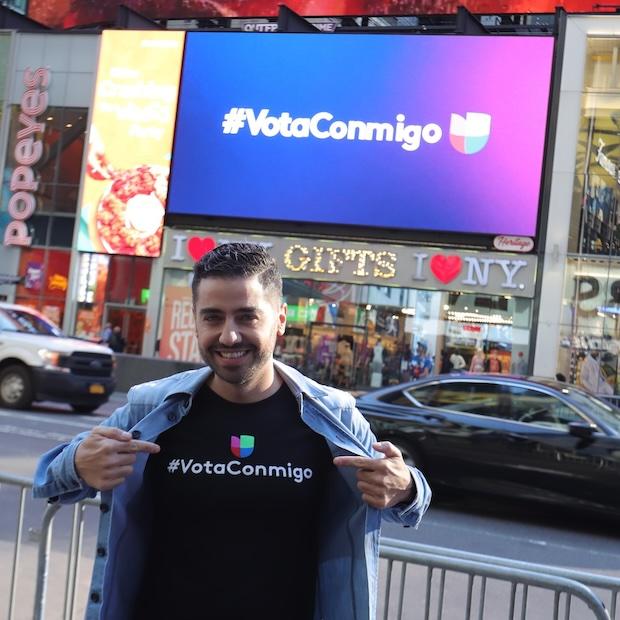
Newscaster Borja Voces, who will vote for the first time in the 2024 U.S. election, strikes a pose at the Vota Conmigo voter registration event in Times Square. With over half the global population set to vote in national elections this year, stories like these are striking a chord with readers. (Image courtesy of TelevisaUnivision)
As we pass the midway point of the year, we're taking a look back at some of the stories our readers clicked most from our weekly Brands Taking Stands newsletter, which covers the latest in corporate and consumer activism.
Considering the U.S. and half of the global population will vote in national elections in 2024, stories about preserving voting rights and election integrity are among the most popular, but readers are also eyeing other hot sustainability topics like gun safety, plastic waste and sustainable consumption. Read on to catch up on the coverage you may have missed, and subscribe to Brands Taking Stands for more stories like these directly in your inbox.
Taking a Stand Against Gun Violence Pays Off For Dick’s Sporting Goods
Dick’s Sporting Goods faced criticism and calls for a boycott from gun ownership activists when it first began scaling back the sale of guns and ammunition in 2012. A dozen years later, the criticism continues.
The National Center for Public Policy Research, a conservative think tank, targeted the company at its shareholder meeting last month with allegations that it harmed financial returns to satisfy executives' political beliefs about firearms.
The only problem is: Dick's sales have never been stronger. Last year's holiday shopping season delivered the biggest sales quarter in the company's history, and it's branching out into new offerings that range from same-day delivery to experiential stores complete with batting cages and practice fields. Meanwhile it continues to respond to public concerns about gun violence.
New Business-Led Pledge Calls on U.S. Political Candidates to Support Election Integrity
We published this story last week and it's already among our most popular for all of 2024 — a clear sign the upcoming U.S. election is at the top of our readers' minds. Launched at the end of June, the Federal Candidate Pledge to Respect Elections calls on candidates for president and other federal offices to uphold the basic democratic guarantee of free and fair elections.
Launched by the Leadership Now Project, a bipartisan nonprofit that advocates for American democracy, the pledge cites six specific commitments for candidates — including respect for individual voting rights, ensuring the safety of election officials and, above all, supporting the peaceful transfer of power.
More than 125 business leaders co-signed by the time of the announcement on June 26, including LinkedIn Co-Founder Reid Hoffman. "As we prepare for the general election, it is critical that candidates reinforce confidence in our democratic processes, as election instability threatens business operations and economic stability," Hoffman said in a statement. Other signatories include senior executives from across industries and both sides of the political aisle.

This Fund Aims to Scale Packaging Reuse and Refill Systems Globally
At least 14 million tons of plastic are washed into the world's oceans every year, equivalent to more than 280 billion beverage bottles. These plastics break down into smaller and smaller pieces when exposed to the sun, and the resulting microplastics have been found from the top of Mount Everest to the ocean floor — not to mention in human blood, and more recently within testicles and clogged arteries.
Given the scale of the challenge, it's no surprise that readers around the world have a keen interest in how we can possibly solve it. The good news is that we already know the steps to take — we just need to put them into action. The U.N. Environment Program ran scenarios for halving global plastic waste while reducing plastic litter in oceans and the environment by 80 percent, and it found most of the plastic reduction needed to reach that target could be achieved by reuse, refill and new delivery models.
Launched in February by the plastic action group Repurpose Global, the Reuse Outcomes Fund aims to help promising startups in the U.S., Canada and India bring their reuse and refill ideas to market. The fund leverages lessons the nonprofit learned from scaling waste management infrastructure across the Global South and focuses on models that can be scaled and replicated globally in the coming years.
Nonpartisan Ways Brands Can Support Free and Fair Elections in the U.S.
Standing up for the basic tenets of democracy — such as the right to vote without interference and have that vote be counted — is not partisan. And business leaders don't need to back a candidate or make a political statement in order to get involved.
We spoke with democracy advocates about non-partisan ways U.S. businesses can support voting rights and election integrity in 2024 — from giving employees paid time off to vote and volunteer as poll workers, to directing stakeholders toward trusted sources of essential election information like voter registration deadlines.
Sustainable Brands Are Worth $44 Billion to U.S. Consumers, New Study Finds
We often hear that consumers are looking for sustainable products and brands, and that many are even willing to pay more for them. But it’s often difficult for brand leaders to pin down just how much of an impact sustainability really has on consumer purchasing, making it harder to tie investments in sustainability to the bottom line.
Earlier this year, TriplePundit and our parent company 3BL teamed up with the research technology firm Glow and panel partner Cint to put a dollar figure on consumer affinity for sustainable brands for the first time. The number was big, and it clearly caught our readers' attention.
In 2023 alone, we found a $44 billion impact across 12 U.S. industries as consumers switched from one brand to another for sustainability reasons. About a quarter of U.S. consumers stopped doing business with a brand last year because of its social or environmental behavior. "In this study we show, as has been shown previously, that this issue is almost universally important to consumers," Mike Johnston, data product leader at Glow, said during a webcast interview hosted by TriplePundit. "We also show there's an expectation for businesses to act on these issues."
The 2024 Consumer Insights & Sustainability Benchmark, released by TriplePundit and 3BL last month in partnership with Glow, takes a closer look at what's driving this billion-dollar shift, how consumers define companies as sustainable, and what they expect from the business world this year.
Inside TelevisaUnivision's Media Blitz to Drive Voter Registration
Civic engagement groups predict about 17.5 million Hispanic and Latino voters will cast a ballot in the U.S. elections in November, a 6.5 percent increase over 2020. With the Vota Conmigo voter education campaign, the Mexican-American media company TelevisaUnivision and partners across the United States aim to increase Latino participation even further to 20 million at the polls.
"This is about democracy," said Teri Arvesu, SVP of social impact and sustainability at TelevisaUnivision. "It doesn't matter who you vote for, I don't care. It's about showing up. And that means something fundamentally much deeper for our community when so many of our families came here from countries where they would not have been able to exercise that right to vote or to participate in a democratic society."
Spanish for "Vote With Me," the Vota Conmigo campaign focuses on providing essential election information to Hispanic and Latino voters. The nonpartisan effort reached 770 million media impressions and registered 1.3 million new voters ahead of the 2020 election. The 2024 campaign kicked off in May with an activation in New York City's Times Square, and it will continue in person, on the airwaves and online through Election Day.
Support for the Anti-ESG Movement Is Dwindling, But Uncertainty Looms Ahead of Election Day
Pushback against the use of environmental, social and governance (ESG) factors in business gathered momentum in the U.S. back in 2021 when legislators in approximately two dozen Republican-led states passed anti-ESG laws.
Some of these laws restrict state agencies or public pension funds from using ESG factors in their investments. Others ban state and local entities from doing business with specific financial companies that legislators deemed to be unfairly disinvesting from the oil and gas sector because of ESG screens.
Signs indicate the news cycle — and the general public — appear to be moving on from the anti-ESG narrative, but upcoming elections in the U.S. and around the world still have some business leaders nervous about what's ahead.

Third-Party Verification Labels Can Guide Sustainable Shopping, If Consumers Know About Them
"People are increasingly conscious of their purchasing habits and want to make sure they are shopping for products that match their values," said Nicole Condon, U.S. director at the Marine Stewardship Council, a nonprofit certifier of sustainable seafood. "We’re seeing that consumers are growing more aware of how their purchasing habits impact the environment and, when given the information to make a more sustainable choice, they’re doing just that."
Though a growing segment of consumers are looking to shop more consciously, the ever-increasing volume of sustainability claims creates confusion and makes it harder to differentiate verifiable product attributes from marketing fluff. Third-party verification labels can help point consumers in the right direction, but only if people know what these labels mean and why they should look for them on the products they buy.
We spoke with Condon about how product certifiers, brands and retailers can build awareness of green labels in a Brands Taking Stands story that proved a hit with readers this spring.
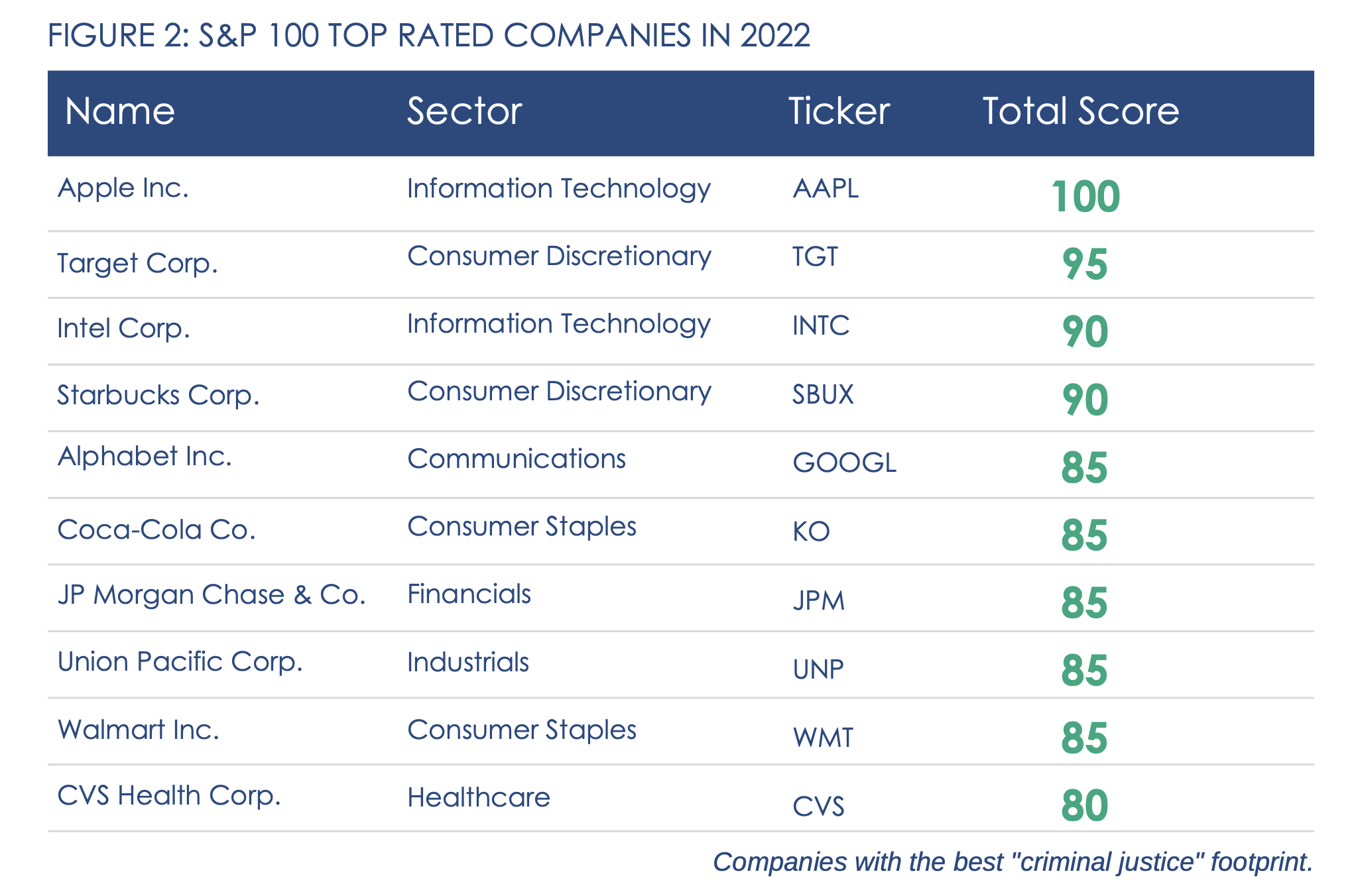
Do Your Investments Support the U.S. Prison System?
When most people think about companies profiting from the U.S. criminal justice system, private prisons are likely the first thing that comes to mind, but that's only the tip of the iceberg. More than 1.2 million people are incarcerated across the United States. The vast majority of them — over 90 percent — are housed in public prisons run by states and the federal government, at an average annual cost of more than $40,000 per person.
"It costs as much to send someone to prison as it does to send them to college," said Tanay Tatum-Edwards, CEO and founder of FreeCap Financial. "And that money is all going somewhere."
Research released by FreeCap Financial in February gave us more insight into exactly where it's going. The data provider's 2023 Criminal Justice Report ranks the largest U.S. companies based on their vending contracts with prisons, use of prison labor and fair chance hiring policies for people with criminal justice histories. It tracks more than $8.6 billion in contracts between state and federal prisons and Russell 3,000 companies from 2019 to 2022.
The research is meant to inform asset managers about how the companies in their portfolios interact with the criminal justice system and ensure their investments align with their clients' values. Launched in May, the FreeCap Financial BITA Decarceration Index translates this research into an investable product, and backtesting indicates it beat the iShares S&P 500 Index for two out of the last three years. While the FreeCap Index is limited to asset managers and researchers at present, a retail fund for everyday investors is expected in 2025.
Don't forget to subscribe to Brands Taking Stands for more coverage like these. Have an idea for a story you'd like to see us cover in a future edition of Brands Taking Stands? Tell us about it here.
Pulling Back on DEI is Not That Simple
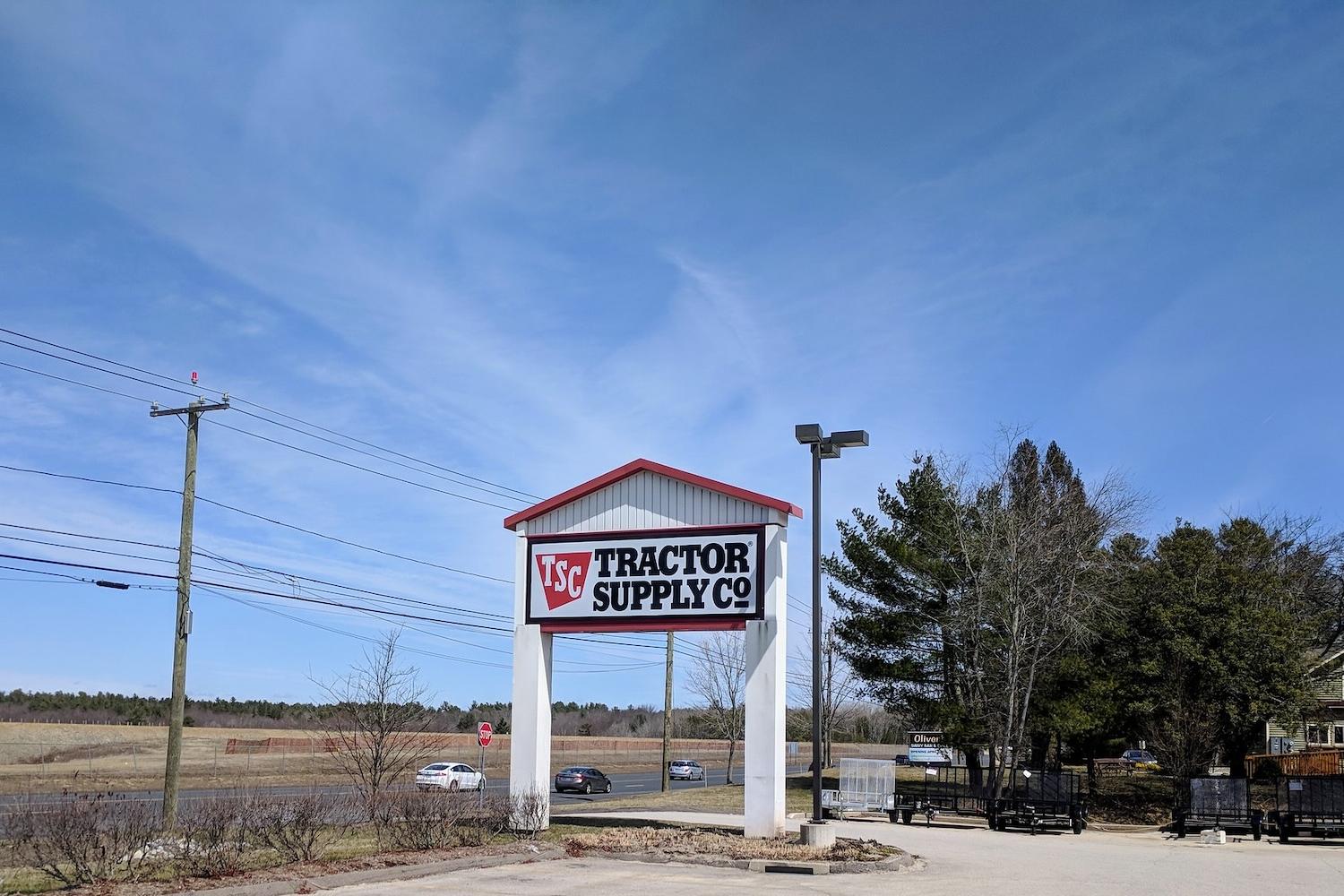
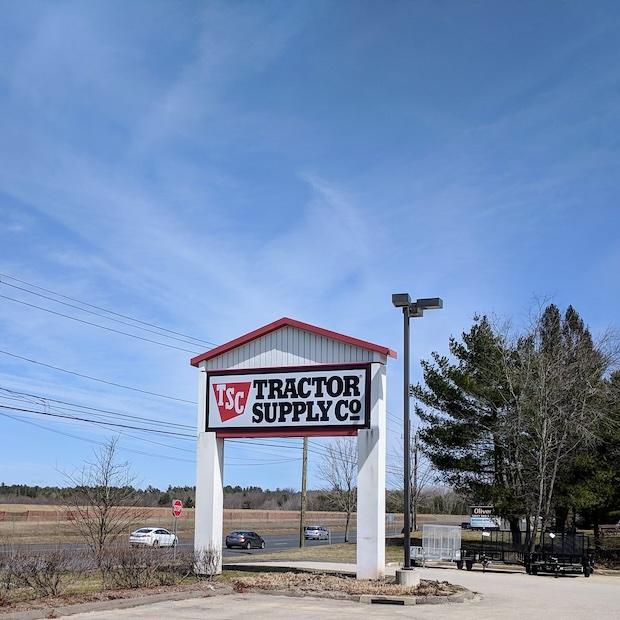
(Image credit: JJBers/Flickr)
Social media erupted in recent weeks after the leading retailer Tractor Supply Co. abruptly announced it is dropping all DEI (diversity, equity and inclusion) programs and dispensing with its decarbonization goals. The announcement may appease some right-wing critics, but it exposes the company to competition from other retailers that are seeking a share of the growing rural market.
Tractor Supply Co. ditches DEI
When Tractor Supply announced the move on June 27, the company referenced feedback from customers who expressed disappointment in some of its civic initiatives, stating it has “taken this feedback to heart.” While affirming support for veterans and the outreach programs of the U.S. Department of Agriculture, the company said it will not sponsor any more “nonbusiness activities" and specifically mentioned “pride festivals and voting campaigns.”
In addition, Tractor Supply pledged to eliminate its DEI positions and goals, replacing them with the neutral and ambiguous standard of ensuring a “respectful environment.”
The National Black Farmers Association claps back
Although Tractor Supply presented the announcement as a simple, straightforward solution to a customer relations problem, the response raises a complex web of issues rooted in the history of the United States and its agricultural industry.
First and foremost, the company’s very public, forceful pullback on DEI presents a jarring contrast to the current of conversation around the loss of Black-owned farms, including recent efforts by the U.S. Department of Agriculture to address discriminatory loan policies that pushed Black farmers from their land in the 20th century. Industry peers like John Deere have also spoken up about it.
The National Black Farmers Association refocused attention to those issues on July 2 when it released a statement calling for the resignation of Tractor Supply President Hal Lawton.
National Black Farmers Association President John Boyd, who is also a shareholder and customer of Tractor Supply, said the retailer's announcement is “reflective of the ongoing racial tension and division in America.”
"This affects our 130,000 members, many of whom regularly shop at Tractor Supply,” Boyd added in the statement. “Having repeatedly attempted to discuss our concerns with Mr. Hal Lawton, I am now calling for his immediate resignation."
The Association also noted that Tractor Supply participates in “predominantly white farm shows and events while snubbing events and opportunities for Black farmers." It says the company “has never displayed a booth or sponsored an event or training opportunity for Black farmers, denying them the respect and dignity they deserve," and emphasized “this behavior is reflective of the widespread disdain that still exists in the agricultural industries toward people of color."
Partners in youth agriculture and veterans services continue to support DEI
The decision also places Tractor Supply at odds with the very groups it claims to support. The nonprofit U.S. Vets, for example, is among the veterans advocacy organizations that recognize and speak about how diversity and inclusion programs address historical injustices that impact veterans’ employment and housing. U.S. Department of Defense officials also note that the pool of qualified recruits in the prime 18 to 24 age group is shrinking, making outreach go diverse communities vital to its future.
Future Farmers of America (FA) is one of the Agriculture Department's rural outreach programs that Tractor Supply still claims to support. However, as with the Defense Department, FFA recognizes that its future depends on connecting with historically excluded groups. Recent outreach efforts include a new, streamlined leadership and education pipeline in partnership with the DEI-centered organization Agriculture Future of America.
The National 4-H Council, another Agriculture Department-affiliated group that Tractor Supply supports, is also in the process of reforming its past practices to align with the diverse demographic profile of 21st-century America and address the "widening opportunity gap affecting young people."
Leaving ground open for other retailers
Tractor Supply's move away from DEI also exposes the company to competition from other retailers in the rural U.S. markets it predominantly serves. Some farmers who oppose the company's decision told news outlets they plan to take their business elsewhere, and industry peers with strong DEI profiles may be well positioned to step in.
Lowe’s, for example, opened 300 new stores in rural areas last year, which are designed around the appeal of one-stop shopping for rural customers. "We now expect that these stores will be a key component of our operating profit growth over the next three to five years," Lowe's CEO Marvin Ellison said during a 2023 earnings call, as cited by Business Insider.
Business Insider reporter Ben Tobin also took note of the investment group Jeffries, which observed the "opportunity for market share shift as Lowe's takes a page out of Tractor Supply's playbook."
As for the page in the Tractor Supply playbook that revoked DEI policies, Lowe’s skipped that one. For example, last year Lowe’s launched a new outreach program that casts a wide, diversity-oriented net to fill gaps in construction industry workforce training. The company's internal inclusion policies contribute to regular appearances on the Great Places to Work list.
Lowe’s EVP of human resources, Janice Dupré, also draws out the connection between bottom-line results and a strong DEI profile. She came to the retailer as its first chief diversity officer in 2017 following an extensive career that included work in finance and accounting at Dell, IBM and EY.
“Diversity is our greatest strength, and inclusion allows us to accomplish together what is impossible to achieve alone,” a statement from Dupré on the Lowe’s website reads. And that just about sums it up.
How a Tech Accelerator is Leveraging Artificial Intelligence for Good
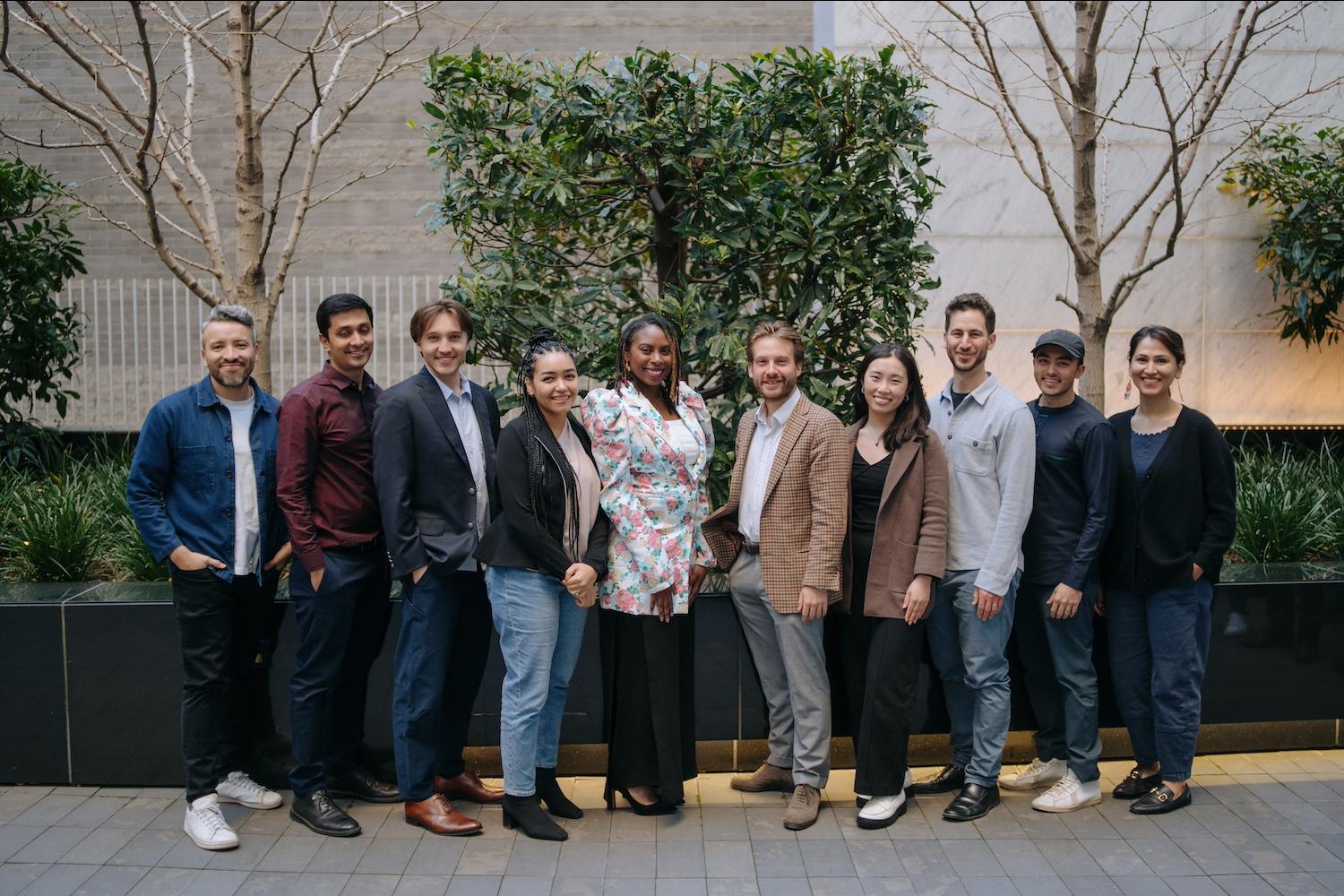
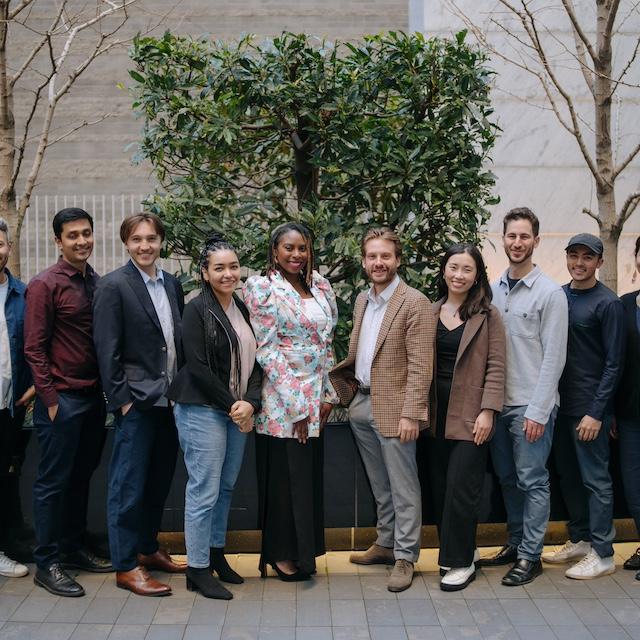
The founders of the artificial intelligence startups in the most recent cohort of Fast Forward's accelerator program. (Image courtesy of Fast Forward.)
At a time of unprecedented technological progress, the potential to harness tech for the benefit of humanity has never been greater. At the forefront of this pursuit is Fast Forward, an organization focused on scaling startups that combine technology with sustainable nonprofit business models.
Under its AI for Humanity initiative, Fast Forward is focusing on using artificial intelligence (AI) to build solutions for global issues. “Apart from early tech nonprofits like Wikipedia, Khan Academy or Mozilla, it didn't feel like there were enough examples of people who were using tech to make the world better,” said Kevin Barenblat, co-founder of Fast Forward. “So our vision for the AI for Humanity initiative is to support entrepreneurs who are building and using AI to make the world better.”
This vision aligns with the growing global dialogue around AI, including its role in achieving the United Nations Sustainable Development Goals and as key component of the 2024 Force for Good technology report.
Founded over a decade ago, Fast Forward supported over 100 tech startups and is a prominent player in the “tech-for-good” landscape via its startup accelerator program, which just completed its 11th cohort. This round comprised of 12 startups, two-thirds of which are harnessing the power of AI to tackle issues like poverty, healthcare inequity, education disparities, environmental injustice and more.
AI startups in the portfolio are empowering scientists in low-income countries to cure neglected diseases, reducing backlogs in Indian courts to ensure fair and speedy trials, bridging the global digital divide by bringing online learning offline, addressing early childhood education disparities in India, and providing free, virtual mental health interventions to people who need them.
What’s more, Barenblat estimates about a quarter of the 100 startups Fast Forward worked with are now aggressively moving into AI. “The newer organizations are more likely to have AI at the center of what they do,” he said. “Some have more traditional technology models and are now adopting them for AI. Or some have used older forms of AI, like machine learning, and are now building on more modern generative AI tools.”
One of the most obvious and powerful uses for AI is managing incredible volumes of data, Barenblat said. One example is Reboot RX, a startup working to fast-track affordable cancer treatments using repurposed generic drugs, AI technology and innovative funding models.
“Mounds and mounds of research exists, but no human can read it all,” Barenblat said. “So Reboot RX uses AI to read through the articles, papers, and research studies to identify the most promising drug candidates, and then tries to find funders who want to pay for the additional research and clinical trials for those drugs.”
Reboot RX raised nearly $6 million so far and was part of Fast Forward’s 2020 accelerator cohort.
Yet as AI evolves, so do the ethical considerations associated with its deployment. Barenblat acknowledged that AI is just like any tool and can be used in many ways. "AI, to me, is like the world's invented a new kind of wrench,” he said. “It's not just about the tool, but about the impact it can have."
But nonprofit entrepreneurs are typically focused on solving social problems, leading them to use AI ethically and responsibly, Barenblat said. “We often see in the for-profit world that people build these cool tools and then they try to figure out what problem they solve,” he said. “But in the nonprofit space, the entrepreneurs are typically fixated on the problem — be it education, health inequity, or the climate problem — and they're slotting in AI to make their solution better. Because they're using AI for a specific use case, they can set guardrails that are appropriate for the way that they're using the AI.”
Despite being a revolutionary technology, AI nonprofits face all the challenges of any tech startup and nonprofit. “Tech startup challenges include things like getting product-market fit right, competing for resources and funding, and usually they focus on marginalized customers who are not easy to reach,” he said. “So I think AI helps, but at the end of the day, they're still trying to help humans.”
Over the years, Fast Forward garnered support from major tech giants like OpenAI, Google and Salesforce, all of which provide funding and technical expertise. “It’s usually the investors and philanthropists who are impact first [that support the organization],” Barenblat said. “Also, there are some that are very AI-driven, but most of them are very thesis-driven. They're very much interested in, let's say, climate change or education or health, and it just so happens that now there are tools that can enable that kind of impact for much less cost.”
That philanthropic drive aligns with Fast Forward’s commitment to shaping a future where AI amplifies human capability, rather than replaces it, Barenblat said.
"The story of AI is not yet written, and it’s being written by us," he said. “AI presents us with this unique opportunity to write the future. I don't think AI is actually going to solve any of these problems like health, education, climate or inequities, but it gives humans the opportunity to do so. I do this work because I feel like we have a choice to make and it's really up to us to decide that we want to use AI in this way.”
Closing the Loopholes Mining Giants Use to Avoid Taxes


Heavy equipment at the Chuquicamata copper mine in Chile. (Image: Bruna Fiscuk/Unsplash)
In this series, we’ve explored many of the impacts of mining projects on the natural environment and nearby communities. Our focus is examining the solutions to these problems that ensure the minerals necessary to power the low-carbon energy transition can still be secured.
The subject of today’s exploration is taxes. While that might sound like an immediate snoozer, the tactics employed by mining companies to shift profits from one country to another are fascinating, to say the least. Depending on how you look at it, you might also describe those tactics as manipulative and morally suspect.
Whatever your take is, it’s hard to deny that the countries and communities relying on that tax revenue are being done some form of injustice.
“The harm in this case is indirect, but it's still serious because often the dream of having more public services and public resources can actually generate support from local communities for extractive projects,” said Tove Maria Ryding, policy and advocacy manager for tax justice at the European Network on Debt and Development. “Many mining communities do not have proper schooling or health care.”
The Organization for Economic Co-operation and Development estimates between $100 billion and $240 billion per year in tax revenue is lost globally due to corporate profit-shifting practices. Is it all legal?
“It’s a big grey area,” says Thomas Lassourd, lead on tax and extractives at the Intergovernmental Forum on Mining, Minerals, Metals and Sustainable Development (IGF). “Some of it is legal as long as local laws and regulations allow it, but some companies really stretch the interpretation of the law.”
Lassourd and IGF work with governments worldwide to uncover profit-shifting schemes and help those countries recover some of their lost tax revenues.
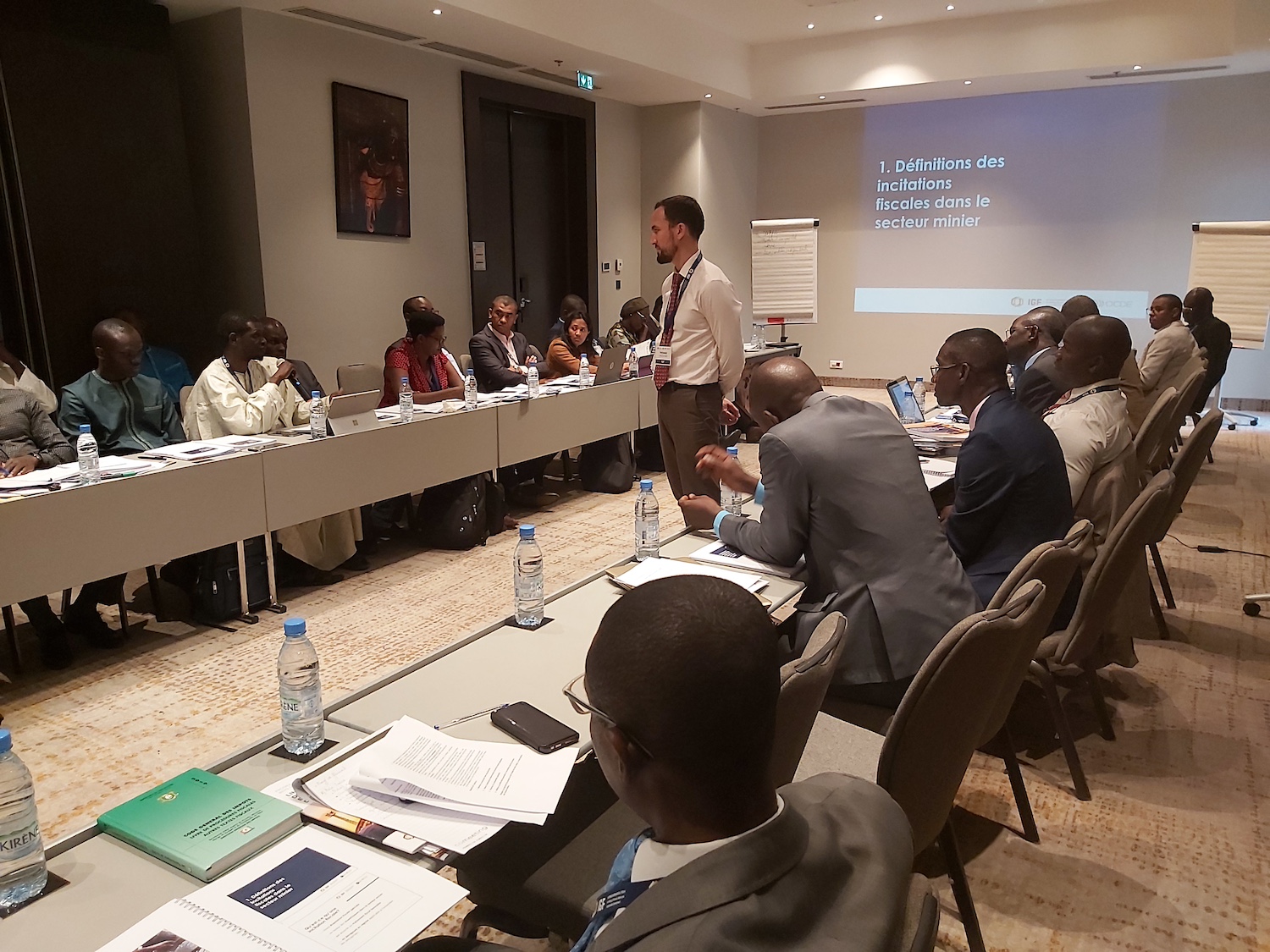
How multinational mining companies shift profits
“What it all boils down to is the fact that the tax system is just not very well designed to tax multinational corporations,” Ryding said. “A mining company is taxed as an independent company in every jurisdiction where it operates instead of as one global company.”
This system allows mining companies to shift profits to sister companies in low-tax countries, avoiding the higher tax rates in countries where they extract and process minerals. These tax avoidance strategies are captured under an umbrella term: base erosion and profit shifting. One of the more common methods is transfer pricing, by selling products or services to a sister company in another country at prices absurdly high or low as compared to fair market value.
“Developing countries are very tired of having a global tax system that just doesn't benefit them, doesn't work for them and doesn't give them much revenue,” Ryding said.
Work that Lassourd and IGF did in West Africa with the government of Guinea provides a real-world example. They saw some irregularities in export prices of bauxite, an ore that is the world’s main source of aluminum. While IGF doesn’t know if mining companies are engaging in aggressive transfer pricing schemes, it acknowledges the rarity of the export prices.
“I don’t have information on how these companies were structured, and we don’t know exactly if every company was using a profit shifting scheme,” Lassourd said. “What we were able to see, however, is that bauxite in Guinea was exported much lower than what market prices would have us think it was worth.”
Using transfer pricing tactics to sell products, services, or raw materials to sister companies at discounted rates reduces the profits in the country of extraction and shifts them to the low-tax country when that sister company eventually sells the minerals. The parent company earns the same profits, minus the costs associated with transportation, but pays the preferred tax rate instead.
On the recommendations of Lassourd and IGF, Guinea implemented a safe harbor regime for bauxite export prices, which is a calculated range of prices that the Guinean government deems acceptable. If mining companies export bauxite within the safe harbor, those transactions are free from being audited. If they export outside of that safe harbor, they may be subject to investigation by the government.
By keeping bauxite export prices within this safe harbor, neither the government nor the mining companies have to exhaust major resources by engaging legal teams and conducting audits.
Similarly, IGF recently helped Senegal implement a safe harbor price range for phosphate. Phosphate sales in Senegal totaled nearly $950 million in 2022, while mining companies paid just $13 million in taxes to the Senegalese government that same year.
Transfer pricing can be applied to more than just minerals. Sister companies may sell professional services, capital assets, or other company property between each other to shift profits out of high tax jurisdictions. High-interest loans are also a common profit-shifting practice, with the interest payments conveniently moving money out of high-tax jurisdictions.
Challenges closing the profit shifting loophole
With mining giants having operations in many different countries and a suite of subsidiaries with which they can exchange products and services, trying to keep track of all of their fiscal maneuvering can be quite challenging for governments with limited resources.
“One of the issues is that a lot of countries don't have up-to-date laws and regulations on base erosion and profit shifting,” Lassourd said. “Another issue is that even when countries have updated laws and regulations on transfer pricing, they might not have the capacity to enforce them very strictly.”
A further complicating factor with transition minerals like lithium and bauxite is the lack of clearly established market prices.
With gold, silver or copper, for example, market prices are well established and easily found. Transition mineral prices are not as clear, and a handful of companies may control the market for these minerals. The volatile nature of mineral markets adds complexity to determining fair market values.
Changing tax policies is also not so straightforward. Countries that do this run the risk of being sued by companies in international arbitration courts. This mechanism, called investor-state dispute settlements, provides an outlet for companies to sue governments when they change laws on things like taxes, environmental protections or human rights.
More than one-third of these cases are brought by mining companies against states that have nationalized mining projects or sought to boost taxes, according to one report. The threat of investor-state dispute settlements, which are sometimes multibillion-dollar lawsuits, can freeze a government into inaction, a phenomenon known as regulatory chill. An issue we previously covered for this series.
How organizations are closing these loopholes
Organizations like IGF, the Global Alliance for Tax Justice, the European Network on Debt and Development, and Tax Inspectors Without Borders are all working behind the scenes to ensure that multinational mining companies pay their fair share of taxes in the countries where they are due.
When IGF assisted Mongolia with its tax policies, it audited a large multinational mining company and found that an additional $228 million in taxes should be paid. The company quickly paid the bill in full.
As Argentina prepares for the transition mineral boom, it called IGF for assistance. IGF used financial models to guide the government’s tax policies on copper and a pricing framework for lithium to help review transfer pricing. Argentina is part of the lithium triangle in South America where massive lithium deposits are also in Chile and Bolivia.
On the regulatory front, the Organization for Economic Co-operation and Development (OECD) developed a few frameworks on tax base erosion and profit shifting, which over 145 countries signed. But critics argue these efforts were ineffective.
“There is fatigue from many countries about the OECD's attempts to try and fix the problem,” Ryding said. “The OECD has been in charge of corporate tax for over 50 years. They created the system that's not working, and then they had two failed attempts to fix it.”
There is much more optimism that a new UN convention on international tax could move the agenda in the right direction. Member parties are currently discussing the details of this convention.
“The process at the UN allows for public accountability,” Ryding said. “The negotiations are live-streamed, and we can be in the room.” This is in stark contrast to the OECD tax negotiations, which are held behind closed doors.
IGF has also showcased and analyzed innovative tax policies and other revenue tools used around the world. Ecuador, for example, adopted a sovereign adjustment mechanism in its 2008 constitution that guarantees the country at least half of all financial benefits from mining projects.
How the business community can support responsible taxation
While the issue of taxes is generally something that governments handle, stakeholders still have the ability to apply pressure on companies.
“I always say that tax should be part of the ‘G’ in ESG,” Lassourd said. Environmental, social and governance (ESG) issues are reported and considered by many businesses and investors. The practice provides investors insight into how businesses are managing risks and impacts related to ESG issues.
“Investors have actually started raising concerns and taking action,” Ryding said. “Sometimes we see governments get so frustrated with big corporations making a lot of money in their country and not paying adequate taxes. This can prompt governments to take unilateral action, and it can turn into legal battles and a lot of uncertainty for companies and their investors.”
This story is part of our investigative solutions journalism series exploring the hidden human rights costs of the low-carbon transition and potential interventions to prevent the negative impacts of mining as we race toward the net-zero energy transition. Read the rest of the series here.